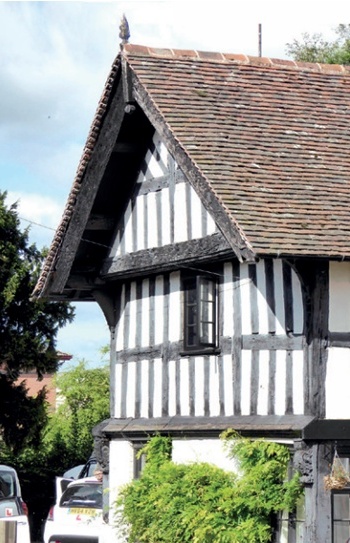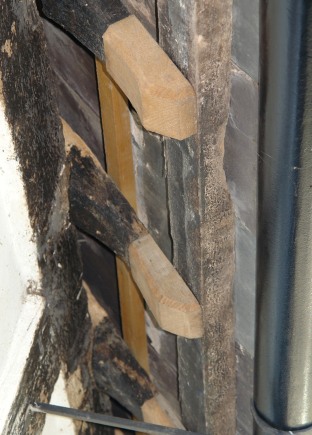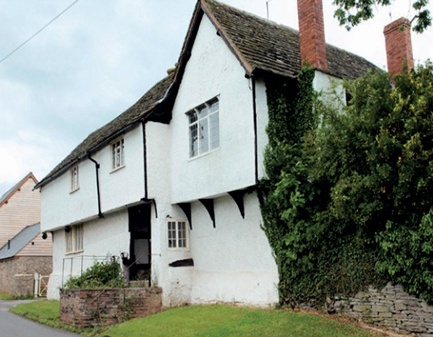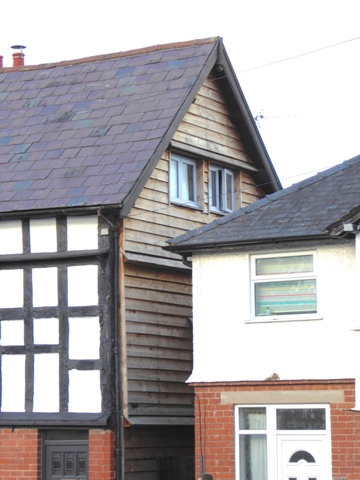Insulation in Timber-framed Buildings
Robert Demaus
 |
|
| The large original verge overhangs of this historic timber-framed house protect the wall below, while an angled ‘pentice’ board above the ground floor window sheds water away from the wall below. (All photos: Robert Demaus) |
Thermally, timber-framed walls generally perform badly compared with other traditional construction, and struggle to meet modern expectations. This article addresses the problems and risks associated with retrofitting insulation to upgrade their thermal performance. It focusses on cases where the timbers are exposed externally, which are usually the most problematic, but also considers timber frames which are concealed behind cladding (either of the same period or later).
There are circumstances in which retrofitting insulation to a timber-framed wall is acceptable and beneficial, but other measures might prove more cost-effective and less damaging. To determine the best way forward, survey and analysis should be carried out by an independent consultant rather than by a materials supplier or contractor. As well as comfort, cost-saving and environmental gain, many other factors must also be considered, including:
- The historic significance of the building as a whole, as well as the relative significance of individual elements, and the degree to which retrofitted insulation will alter it
- The condition of the building fabric and the nature and extent of any interventions (other than thermal insulation) that might be necessary
- The causes of any existing degradation and how these might best be remedied
- The current hygrothermal performance of the timber-framed walls and the building as a whole
- The ‘landscape value’ of the building and the potential impact of any change to its external appearance
- The performance of heating and hot water systems and the cost benefit of upgrading
- The condition and efficiency of existing insulation, for example in roof spaces and floors, and the cost benefit of upgrading
- The potential for introducing cost-effective and reversible new elements such as secondary glazing that do not involve significant harm to historic fabric
- The building’s current use and the occupants’ expectations.
The absolute and relative importance of these and other factors will vary greatly, not just between buildings, but between areas of the same building.
The thermal performance of a timber-framed wall is not only controlled by its component materials. Condition, orientation and exposure will have a far greater effect on a 100mm thick timber-framed wall than on a 225-350mm brick wall. Moisture retention within the wall is also critical to its thermal performance.
Timber frames are full of joints and cracks through which air (and water) can penetrate. The most effective improvement that can be made to the overall hygrothermal performance is to fill these gaps. A sensitive thermographic camera is the best way of locating them, provided there is a reasonable temperature difference (5-10°C) between the inside and outside, and preferably when the wind is blowing. It is as important to survey the outside of the building to identify where heat is escaping, as it is internally to identify where cold air is entering. The survey should be repeated when the remedial work has been completed, but is almost meaningless unless carried out in the same weather conditions. Most timber-framed buildings are too air-porous for standard air pressure tests to be meaningful.
Optimum methods and materials for gap filling will vary depending on the size and location of the gaps, but should always be flexible and breathable: sheep’s wool pushed into the gap with a thin blade and finished with haired lime plaster can be very effective. Proprietary sealants, mastics and cementitious mortars should not be used.
 |
|
| This timber-framed house has retained its original eaves and verges, both beautiful and practical. The house must always have been tiled. | |
 |
|
| The depth of thatch shelters the wall below. If the thatch were replaced with tile or slate (as so much was) the wall becomes very vulnerable. | |
 |
|
| These rafters have been restored to their original overhang, greatly improving protection of the wall below. |
There is a much greater variety of constructional materials and details in timber-framed walls than might be found in brick or stone walls, with correspondingly complex, variable and unpredictable physical properties and interactions. Moreover, the original wide palette of materials is often further complicated by subsequent alterations and additions, such as changes from wattle and daub to brick infill, from lime to cement render and from permeable to impermeable finishes. Many of these variations can occur within a single elevation. By comparison, brick and stone walls are relatively homogeneous and predictable.
As a result, desktop heat-loss calculations using standard formulae and computer modelling are less reliable where walls are timber-framed. On-site detailed physical investigation is required. Sensitive infrared thermographic cameras may be used to locate concealed timbers, identify the make-up of infill panels and assess heat loss and damp penetration. Decay-detecting micro-drills are also very useful for these investigations.
For such assessments to be of value, the assessor must have a good working knowledge of how the building was constructed, what changes might have occurred since, and the causes and extent of any degradation.
Typically, timber-framed buildings were built using freshly felled timber that shrank and moved significantly, particularly over the first 30 years. The timbers were usually left exposed externally and internally and the spaces between the frame were filled with clay-based daub, often finished with limewash. Gaps that formed between the frame and infill as the materials settled and shrank were regularly filled and additional coats of limewash applied.
The entire fabric was therefore very breathable, allowing any moisture that entered to readily evaporate, and moisture levels in the wall generally remained below the point at which the various materials would degrade. The walls were protected by large roof overhangs and pentice boards (see title illustration), but over the following centuries, these were lost, causing the walls to be wetter more often and for longer periods. As a consequence, the wattle and daub began to degrade rapidly and the timber more slowly.
In the 18th and 19th centuries timber-frames were often concealed behind facades of weatherboard, brick, tile or lime render. Early renders were lime-based and breathable: later renders were often much less breathable, such as Parker’s Roman cement which was patented in 1796.
Where frames remained exposed into the 19th century, the degraded wattle and daub was often replaced with brick, which tended to exacerbate degradation. Increasing use of cementitious renders, impermeable paints, damp-proof membranes and mastic sealants in the 20th century tended to reduce breathability and trap water, increasing degradation and heat loss.
More recently, economic and environmental pressures to improve thermal performance have become increasingly important, but often poor detailing and inappropriate materials have exacerbated decay.
In the 21st century there has been a growing understanding of the need for buildings to breathe and a consequent move to more permeable materials. The crucial point is that impermeable modern finishes and sealants not only cause significant and continuing damage to the timber frame and other historic fabric, they also greatly diminish the thermal performance of the wall.
The condition of the wall and its hygrothermal behaviour are intimately linked. Unless faults are remedied, the introduction of insulation may be of relatively little benefit and can greatly increase the risk of further deterioration. Only when the detailed survey has been completed can the advisability of retrofitting insulation be evaluated and the best method selected.
There are essentially three options for retrofitting insulation to an exposed timber-framed wall; externally, internally or within the depth of the frame.
WITHIN THE FRAME
Given that timber-framed walls are often less than 100mm thick, insulating within the depth of the frame almost inevitably involves loss of the existing infill material.
Original wattle and daub should be retained and repaired if possible, but where there is a later brick infill, its historic and aesthetic significance and its condition may affect the decision. Where there is evidence of significant degradation, a good case can be made for its replacement with a more sympathetic and better performing material. Where the timber frame requires repair that involves removal of the infill, there is an opportunity to introduce more sympathetic and better performing infill.
It is now generally accepted that infill panels should be breathable and vapour permeable throughout their thickness, but there are many theories about the best materials and techniques. Many recommended systems involve complex combinations of materials including synthetic edge seals, breather membranes and vapour barriers, stainless steel mesh, wood-wool substrates and softwood sub-frames. Systems such as these may work better in theory than in the variable conditions found on site, where quality control may be difficult, particularly when the timber frame is neither straight nor in perfect condition.
As a rule, the simpler the method and materials, the more likely they are to function predictably and reliably. There is great merit in using methods and materials as close to the original wattle and daub as possible. The theoretically poorer U-value may not be as bad in practice and the greatest reduction in heat-loss is often achieved simply by creating a dry, draught-free structure. A modern material similar in concept to daub, but with more durability and better U-value, is a hydraulic lime/hemp mix that can be cast in-situ to form a homogenous breathable infill.
If the frame and/or the panels are in poor condition and repairs would involve the loss of a high proportion of historically significant fabric, there would be a strong case for protecting the wall behind a shelter coat of lime render or other regionally appropriate material. This is usually preferable to creating a crude modern replica of the wall in band-sawn timber, and may provide the opportunity to insulate outside the wall line.
INSIDE THE WALL LINE
If the timber frame and infill are in sufficiently good condition, and are robust enough to cope with continuing exposure with limited interventions, insulation can be fitted to the inside face, either directly to the wall or with an air gap. However, this will have a serious impact on the appearance of the room, obscuring features such as window surrounds, skirtings and adjacent ceiling mouldings, and it will reduce the internal floor area. More significantly, there is an increased risk that moisture entering the wall will become trapped, even if all the materials used in the new lining (insulation, plaster and paint finish) are vapour permeable. If problems do occur, they are unlikely to become apparent until significant damage has occurred.
The risk of driven rain penetration can be reduced by careful gap-stopping and the reinstatement of overhangs, but any intervention that restricts the passage of water vapour through the wall significantly increases the risk of condensation and/or water entrapment. For this reason, non-breathable rigid insulation such as PIR (polyisocyanurate) boards should not be used, even though they can achieve better U-values at relatively small thicknesses.
Insulating inside the wall line also greatly increases the risk of condensation due to cold-bridging in those areas which, for various reasons, cannot be insulated. In particular, the ends of floor beams and joists built into the external wall are at greater risk of increased degradation.
OUTSIDE THE WALL LINE
For many reasons, fitting insulation to the outside face of a timber-framed wall is often the best solution, both in terms of hygrothermal performance and building conservation.
 |
|
| Historically, many timber-framed buildings were rendered to improve their weather-tightness. Some of the visible render is lime-based and probably early 19th century, other sections have been replaced with a cementitious render in the 20th century. |
- The wall is fully protected (assuming materials and detailing are correct)
- Necessary repairs can be kept to the minimum structurally required, and can usually take the form of additional surface-fixed straps, etc. These repairs are reversible and involve no loss of historic fabric.
- Air penetration through the wall can be fully controlled
- Insulation can be continuous with all original fabric on the warm side, reducing the risk of cold-bridging and condensation
- Keeping what thermal mass there is in the wall on the warm side also helps to balance diurnal variations
- The historic significance and appearance of the interior is not compromised
- The intervention is reversible.
External insulation will alter the external appearance: the additional thickness requires changes to window reveals and other features, and conceals the timber frame. This often meets with resistance, both professional and public. However, there is a strong historical precedent and the benefits are considerable.
Historically, render was usually applied direct to lath nailed to the frame, and it is widely held that this must offer good protection to the frame, simply because it is breathable. However, it is quite common to find widespread active Deathwatch beetle attack in timbers immediately behind lime renders, but rare to find it in exposed external timbers, suggesting that sometimes moisture content of a lime-rendered frame can be high enough to sustain fungal and beetle attack. When applying new or replacing old render, a vapour permeable membrane should be used and the lath set off the frame on counter-battens if possible.
The recent development of relatively high-performance breathable multi-layer insulation quilts, effectively insulated breather membranes, has great potential as they increase wall thickness far less than most other breathable insulation materials. Although designed for use in roofs, these quilts have been successfully used to insulate timber-framed walls behind render or weatherboard. New materials need to be used cautiously until their long-term performance is better understood, but equally, they should not be dismissed out of hand. Furthermore, imported materials that perform well in cold dry climates may not work in wetter UK conditions. Perhaps the best advice is to question everything.
In a surprising number of cases, what appears to be a timber frame is actually an agglomeration of paint, mastic and cementitious render repair concealing a severely degraded and structurally compromised frame. Sooner or later this will require such extensive repair/ replacement that protection with a lime render or other cladding would almost certainly provide a more effective and conservative solution while avoiding further loss. If the appearance of a timber-framed building is deemed desirable, this can always be applied to the face of the new render – there is a long tradition of what many now consider ‘fakery’. At least what remains of the frame and surrounding fabric is retained for future generations.
RELATED REPAIRS
If the timber frame is to remain exposed, the essential first step in improving the thermal performance is to ensure that the frame and surrounding fabric are in good condition, and consist of materials that allow the wall to breathe. A conflict arises where an alteration regarded as part of the building’s history is demonstrably causing damage. Brick infill for example, does not always cause problems, but can significantly increase the rate of degradation of the frame, particularly when bedded in cementitious mortar, where frames are relatively light, poorly constructed or weakened by decay, or where the bricks project outside the face of the frame, creating ledges that trap water.
 |
|
| The severely degraded timber framed end wall has been strengthened and protected behind weatherboarding, with a layer of breathable multi-layer insulation included. |
The use of inappropriate materials is not the only problem. The introduction of impermeable materials was usually prompted by the failure of earlier or original wattle and daub infill, which usually began to fail once the protection of big overhangs was lost. Although impermeable materials are generally damaging, if permeable materials are reintroduced without reinstating the original protection (such as overhangs), their exposure to extensive and persistent wetting will lead to fungal degradation, loss of cohesion and frost damage.
Furthermore, heat loss through persistently wet daub, render or brick is much greater. Recent changes in weather patterns may also create greater problems for poorly protected buildings. It is therefore an essential element of any building upgrade (particularly for timber-framed buildings) that adequate overhangs and other protective measures are re-introduced, even where the evidence for them is inconclusive.
Another important issue is that moisture content is critical and often finely balanced. Typical ambient moisture content of timber in a well maintained building is around 16 per cent (lower if heated). This tends to rise to around 18-20 per cent in well-maintained external walls. Many fungi will germinate at around 27 per cent, but can survive down to 23-24 per cent. Deathwatch beetle thrive where there is or has been fungal activity and can survive in timber down to 16 per cent moisture content or lower.
Controlling water penetration, condensation and evaporation are therefore critically important, and using the wrong materials or details might raise the moisture content by just a few per cent and risk starting or re-starting degradation. Equally, reintroducing the right materials and detailing should lower the moisture content by just a few per cent into the safe zone.
SUMMARY
1 |
The decision whether to retrofit insulation, and if so, which approach to adopt, cannot be taken in isolation. A detailed appraisal of the building, including the historic significance of the timber frame, infill panels and other features, as well as an accurate condition assessment, must be carried out. |
2 |
Most traditional timber-framed buildings will be listed. There should be discussion at an early stage with the local conservation officer about the problems identified and proposed remedies. |
3 |
Upgrading the hygrothermal performance of timber-framed walls by retrofitting insulation is very difficult and can rarely be achieved without significantly compromising the historic significance and/or appearance of the building. Any potential benefits in terms of cost saving, comfort and reduced carbon emissions need to be weighed against the initial cost, loss of historic fabric and potential for further degradation of historic fabric. |
4 |
Where timber-framed walls retain a high proportion of original or historically significant fabric, retrofitting insulation should be considered a last resort and only used when other potential improvements have been explored. |
5 |
Heat loss through the various materials that make up a relatively thin timber-framed wall is often compounded by air leakage around the edges of panels and through joints in the frame. Minimising uncontrolled air movement is critical and will often prove more effective and less damaging. |
6 |
Alternative measures to upgrade the overall performance of the complete building should be considered. These might include reinstatement of roof overhangs and fitting of pentice boards, removal of impermeable materials and finishes, and measures to reduce wind exposure. |
7 |
Timber-framed walls generally have low thermal mass and high uncontrolled air penetration. Heating systems that make use of large internal masonry stacks or stone floors as heat stores are often more effective than systems that heat the air via conventional radiators. Radiators should never be placed against external timber-framed walls. |



